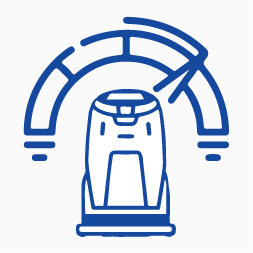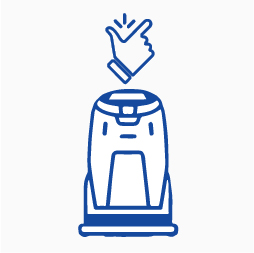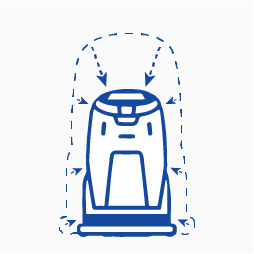UP NEXT
Autonomous Scrubber Maintenance Guide – Elevate Performance & Extend the Life of Your MachineApril 12, 2023

May 02, 2023
Cleaning robots had been with us for a while. The first robotic cleaners appeared on the market back in the 1990s. Relying on ultra-sonic sensors they were able to map the rooms and perform vacuuming autonomously. Even though object detection was fairly reliable, sometimes the robots failed when approaching objects with sharp corners, resulting in collisions. At the same time, due to the need to stop a short distance away from the walls or obstacles, the first-gen robots were leaving some areas uncleaned.

Fig.1 A prototype of the first commercial cleaning robot, developed by Cyberclean Systems 1997
Prototyping of the industrial cleaning robots was happening in the 1990s as well, but it took time to develop a version ready for commercial use. Only in the late 2000s, the first commercial cleaning robots were introduced to the market. Even though the autonomous cleaners at that stage were significantly more advanced compared to the generation before and could perform some other key cleaning tasks such as scrubbing and drying, there were still some significant downsides that were stopping them from taking over the cleaning service industry.
Some significant reasons for that were:
Despite all these deficiencies, the first-gen autonomous cleaners paved the way for the development of more advanced machines for professional cleaning services. With the advances in both cleaning equipment hardware and autonomous navigation software, robotic cleaning solutions reached a completely new level of performance by the midst of 2023.

Fig.2 Scrubber 50 Pro in the office building lobby
 Cleaning Productivity Reaches New Heights
Cleaning Productivity Reaches New Heights
In 2023 cleaning productivity and efficiency are reaching new heights. Some relatively compact robotic cleaners such as Scrubber 50 Pro (*w700*H1,030mm) are going up to 2,527 m2/h of cleaning output due to the application of side brushes. By combining the main brush (which can be cylindrical or disc-shaped) with two sweeping brushes on each side, the robot offers extended cleaning width and hence elevates the cleaning productivity. The addition of side brushes also allows the robot to clean along the edges and reach tight corners.
Along with the extended cleaning width, today’s scrubbers are equipped with larger water tanks. If we take the Scrubber 50 Pro as an example, it offers a 30L water tank which elevates its capacity by 25% compared to the previous version and allows longer cleaning time without interruption. At the same time, the battery capacity has been increased as well and can provide 3 hours of scrubbing or 8 hours of dust-mopping on a single charge with the durability of 2,000 charging cycles.
 Is Autonomous Navigation Still a Struggle?
Is Autonomous Navigation Still a Struggle?
Unlike the first generation of commercial cleaning robots, in 2023 autonomous cleaners don’t take constantly changing dynamic scenarios as a challenge. Owing to innovative navigation systems that combine enhanced sensor layouts with the latest deep-learning-based algorithms, today’s commercial cleaning robots feel perfectly comfortable with both, static and dynamic objects located around the cleaning site. These advanced sensor positionings also enhance the robot’s accuracy when it’s connecting to a docking station, allowing high precision even in low light conditions.
Another major advantage of Scrubber 50 Pro particularly is the ability to identify polluted areas and provide cleaning of particular spots. Powered by the AI-enabled RGBD camera and deep-learning-based algorithms, Scrubber 50 cleans only where it’s necessary. This “On-demand” cleaning mode leads to a reduction of water, energy, and chemical consumption and elevates overall efficiency up to four times compared to the previous generation of commercial cleaning robots.
 How About the User Experience?
How About the User Experience?
One of the most significant advancements considering the user experience is the automation of the mapping process. Unlike the previous generations, today’s commercial cleaners feature a hassle-free mapping process that does not require physical markers and could be generally done in four simple steps.
Data reporting & mobile app control
Another two handy innovations that many users are already accustomed to are automated performance reports and the ability to manage autonomous cleaners’ tasks via a mobile app. With the ability to monitor the performance of the robotic cleaner and to adjust it from anywhere via a mobile app, the whole user experience reached a new level.
Intuitive interface
Some of the most advanced cleaning robots such as Scrubber 50 Pro also feature a neat-looking self-explanatory operator panel for a more intuitive operation. To prevent confusion its software integrates options for making it easy to adjust settings and personalize the cleaning experience.
 Continuous Pursuit of Higher Reliability and Durability
Continuous Pursuit of Higher Reliability and Durability
Along with the development of cleaning machinery and autonomous navigation, reliability and durability improved as well. Unlike the first generations of robotic cleaners that could frequently break down and lead to unplanned downtime, today’s robotic cleaners offer improved reliability and durability due to their innovative design and advanced combination of both hard and software components. Battery capacity which is one of the main factors responsible for the durability of the machine has been increasing as well and now can provide 4+ hours of working time (in full operating mode) on a single charge with the durability of 2000 charge cycles.
A vivid indication of the improving performance of the robotic cleaners is a significant increase in their global market size (e.g. it grew from $9.24 billion in 2022 to $11.49 billion in 2023 at a compound annual growth rate (CAGR) of 24.3%)[1].
 Even More Compact and Agile
Even More Compact and Agile
Compared to other commercial robotic cleaners that were originally designed as sit-on machines for a human to drive and hence had a significantly larger size, today’s robotic cleaners are developed to navigate autonomously from scratch, which allows them to offer compact size and high productivity at the same time.
In 2022 some of the leading providers went even further by introducing ultra-compact commercial cleaning solutions like Phantas. Despite its relatively tiny size, this autonomous cleaner integrates all four most needed cleaning functions of the commercial cleaning robot:
The smaller the size, the higher the mobility. Being able to navigate along narrow aisles, corridors, and other tight areas, today’s autonomous cleaners can be applied to a much wider range of commercial facilities, such as small and mid-size grocery stores, building lobbies, office spaces, etc.

Fig.3 Height comparison of Gausium autonomous cleaners in centimeters
By reaching the next level of productivity, efficiency, and overall convenience, autonomous cleaning robots today offer a set of highly valuable characteristics that make them ideal cleaning solutions for industrial cleaning services.
About Gausium
Gausium was founded by Edward Cheng in 2013 out of a passion for autonomous driving. It started as a solutions provider of SLAM (simultaneous localization and mapping) and integrated robotics software. Today, Gausium has become a leading company of AI-powered autonomous cleaning and service robots with more than 4,000 successful deployments in 50 countries and regions. Currently, Gausium’s products and services include commercial floor cleaning robots, indoor delivery robots and supplementary accessories like docking stations, cloud platform and application software.
Reference
[1] The Business Research Company – Cleaning Robot Global Market Report 2023
Step 1/2
Please select the type of business you’d like to have with Gausium.
Choose one item from the list
Step 2/2
Thanks for sharing your preference. Please fill out the form below, and we’ll get in touch shortly.
By clicking “Submit”, I authorize Gausium to contact me. Privacy Policy.
Thank you for filling out the form
By clicking “Submit”, I authorize Gausium to contact me. Privacy Policy.